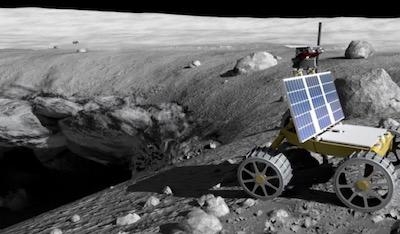Thu, Jun 13, 2019
Could Help NASA Establish A Sustained Human Presence At The Moon
Robotically surveying lunar craters in record time and mining resources in space could help NASA establish a sustained human presence at the Moon – part of the agency’s broader Moon to Mars exploration approach. Two mission concepts to explore these capabilities have been selected as the first-ever Phase III studies within the NASA Innovative Advanced Concepts (NIAC) program.

“We are pursuing new technologies across our development portfolio that could help make deep space exploration more Earth-independent by utilizing resources on the Moon and beyond,” said Jim Reuter, associate administrator of NASA’s Space Technology Mission Directorate. “These NIAC Phase III selections are a component of that forward-looking research and we hope new insights will help us achieve more firsts in space.”
The Phase III proposals outline an aerospace architecture, including a mission concept, that is innovative and could change what’s possible in space. Each selection will receive as much as $2 million. Over the course of two years, researchers will refine the concept design and explore aspects of implementing the new technology. The inaugural Phase III selections are:
- Robotic Technologies Enabling the Exploration of Lunar Pits
- William Whittaker, Carnegie Mellon University, Pittsburgh
This mission concept, called Skylight, proposes technologies to rapidly survey and model lunar craters. This mission would use high-resolution images to create 3D model of craters. The data would be used to determine whether a crater can be explored by human or robotic missions. The information could also be used to characterize ice on the Moon, a crucial capability for the sustained surface operations of NASA’s Artemis program. On Earth, the technology could be used to autonomously monitor mines and quarries.
(Image provided with NASA news release)
More News
Pilot Also Reported That Due To A Fuel Leak, The Auxiliary Fuel Tanks Were Not Used On June 4, 2025, at 13:41 eastern daylight time, a Piper PA-23, N2109P, was substantially damage>[...]
Have A Story That NEEDS To Be Featured On Aero-News? Here’s How To Submit A Story To Our Team Some of the greatest new stories ANN has ever covered have been submitted by our>[...]
From 2023 (YouTube Edition): Reflections on War’s Collective Lessons and Cyclical Nature The exigencies of war ought be colorblind. Inane social-constructs the likes of racis>[...]
Aero Linx: Colorado Pilots Association (CPA) Colorado Pilots Association was incorporated as a Colorado Nonprofit Corporation in 1972. It is a statewide organization with over 700 >[...]
High Speed Taxiway A long radius taxiway designed and provided with lighting or marking to define the path of aircraft, traveling at high speed (up to 60 knots), from the runway ce>[...]
 NTSB Prelim: Piper PA-23
NTSB Prelim: Piper PA-23 ANN FAQ: Submit a News Story!
ANN FAQ: Submit a News Story! Classic Aero-TV: One Mans Vietnam
Classic Aero-TV: One Mans Vietnam ANN's Daily Aero-Linx (07.03.25)
ANN's Daily Aero-Linx (07.03.25) ANN's Daily Aero-Term (07.03.25): High Speed Taxiway
ANN's Daily Aero-Term (07.03.25): High Speed Taxiway



